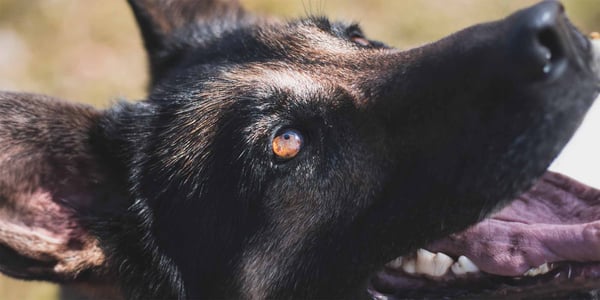Conjunctivitis in Dogs - What Is It and How Can I Treat It?
Index:



Introduction
Conjunctivitis in dogs, also known as "pink eye," is a common eye infection that affects the conjunctiva, the thin mucous membrane covering the inner surface of the eyelids and the white part of the eye. This uncomfortable eye condition often results from the eye’s protective barrier against infections being compromised.
Symptoms of conjunctivitis include redness, swelling, yellow discharge, and discomfort in one or both eyes. It's essential to recognize conjunctivitis symptoms and clinical signs early for the well-being of our dogs. Early detection allows for prompt and effective treatment, preventing potential complications and further discomfort.
By understanding the signs, causes, and available treatment options for conjunctivitis in dogs, we can all take proactive steps to safeguard their eye health and overall quality of life.
Understanding conjunctivitis in dogs



Conjunctivitis in dogs, also known as canine pink eye, involves conjunctival inflammation. It can be caused by various factors, including bacterial or viral infections, allergic reactions, irritants such as dust or chemicals, foreign material in the eye, or underlying issues such as eyelid abnormalities.
Common clinical signs of conjunctivitis in dogs include:
Redness and swelling of the conjunctiva
Tear production or discharge from the eyes
Eye rubbing or pawing
Squinting or blinking
Sensitivity to light
A visible third eyelid
Ocular discharge
Swollen eyelids
The discharge may be clear, watery, thick, or purulent, depending on the underlying cause. In some cases, conjunctivitis may also lead to crusting or matting of the fur around the eyes.
Diagnostic tests and a detailed examination are vital. If you suspect that your dog has conjunctivitis, you should consult a veterinarian for a physical examination and eye examination. The vet may conduct an ophthalmic examination and additional tests, such as conjunctival scraping or allergy testing, to accurately identify the cause and severity of the conjunctivitis.
Depending on the cause, conjunctivitis treatment may include topical antibiotics, anti-inflammatories, or oral antibiotics. In some cases, untreated conjunctivitis can lead to more severe eye diseases like ulcerative keratitis, nodular episcleritis, or corneal ulceration.
After a definitive diagnosis, the vet is likely to prescribe specific medications such as topical corticosteroids for allergic conditions or antibiotics for bacterial infections. Allergic skin testing may be necessary for dogs with seasonal allergies or environmental allergies.
If you’re a Waggel member, you can get exclusive access to 24/7 online vet care with our partner, Joii. Joii is simple to use, just download their app and connect with a qualified vet in just minutes.
As we’ve mentioned above, there are a few different types of conjunctivitis. So let’s take a look.
Types of conjunctivitis in dogs:
Purulent conjunctivitis: This form of conjunctivitis is usually associated with Streptococcus and Staphylococcus bacteria, it causes thick secretions of pus and mucus that may form a crust on the eyelids.
Neonatal conjunctivitis: Neonatal conjunctivitis affects the eyelids of infant puppies before or after their eyelids separate. Prompt veterinary treatment is important to prevent corneal damage and blindness.
Serous conjunctivitis: Serous conjunctivitis is a mild condition that causes pink and swollen membranes, with a clear, watery discharge. It is often caused by irritants like dust, allergens, or cold or windy weather.
Follicular conjunctivitis (mucoid conjunctivitis): Follicular conjunctivitis occurs when small mucous glands (follicles) react to an infection or eye irritant, forming a rough, cobblestone surface that irritates the eye. It typically affects puppies and young dogs and subsides with age.
Allergic conjunctivitis: Allergic conjunctivitis is a form of serous conjunctivitis that can cause itching. It is often caused by household chemicals, lawn and garden sprays, smoke, or other environmental factors.
Keratoconjunctivitis sicca (KCS): Also known as dry eye, involves tear film deficiency which leads to irritation and inflammation. The conjunctiva is usually red and inflamed, and symptoms may include squinting, thick mucus-like discharge, and corneal scarring.
Parasitic conjunctivitis: Rare in Europe, parasitic conjunctivitis can be caused by botfly larvae or the parasitic worm Thelazia californiensis. Eye worms can produce symptoms ranging from mild tearing or discharge to conjunctivitis, keratitis, or corneal ulcers.
Diagnosing conjunctivitis



If you suspect that your dog has conjunctivitis, you should consult a veterinarian as soon as possible. Seeking veterinary attention promptly is crucial for several reasons.
Firstly, a veterinarian will be able to accurately diagnose the underlying cause of conjunctivitis. While conjunctivitis itself may have similar symptoms, the underlying cause can vary significantly, ranging from infections to allergies or other underlying health conditions. Determining the specific cause is important for effective diagnosis and subsequent treatment.
Your vet may suggest diagnostic procedures and tests to accurately identify the cause and severity of the conjunctivitis. This tends to include a thorough examination of your dog's eyes, including an assessment of the conjunctiva and the cornea to check for any scratches or ulcers. Your vet will also look for the presence of foreign objects. They may collect a sample of the eye discharge for laboratory analysis, which can help identify the specific microorganism causing the infection, if present.
After a diagnosis, your vet is likely to prescribe specific medications such as antibiotics for bacterial infections or antiviral medications for viral causes. Allergies may require anti-inflammatory medications or hypoallergenic treatments.
As previously mentioned, Joii is on hand for all Waggel members and offers prompt veterinary care.
Treating conjunctivitis in dogs



Depending on the diagnostic tests, veterinarians will develop a treatment plan that might include topical antibiotics, anti-inflammatories, or even oral antibiotics. Severe conjunctivitis in dogs might require more aggressive treatment.
Some of the more commonly prescribed options include:
Antibiotic eye drops or ointments: These are commonly used to treat bacterial conjunctivitis. They help eliminate bacterial infections and reduce inflammation. Examples include chloramphenicol, gentamicin, or tobramycin eye drops.
Antiviral eye drops: In cases of viral conjunctivitis, antiviral medications may be prescribed to help manage the infection. The specific antiviral agent will depend on the suspected or confirmed viral cause.
Anti-inflammatory eye drops: These medications are used to alleviate inflammation and discomfort associated with conjunctivitis. They can help reduce redness, swelling, and itching. Commonly prescribed options include corticosteroid eye drops.
Some owners worry when prescribed eye drops by their vet. However, don’t fear as we’re here to help. Administering eye drops requires a calm head and steady hands. Our top tips are:
Gently restrain your dog to keep them steady
Hold the eye drops or ointment bottle with one hand and use your other hand to lift your dog's upper eyelid
Carefully place the prescribed number of drops or a small amount of ointment onto the surface of the eye, aiming for the space between the eyeball and the lower eyelid
Release the eyelid and allow your dog to blink, which helps distribute the medication across the eye
If your dog has been diagnosed with conjunctivitis, It’s also crucial to follow the correct treatment prescribed by the vet, as permanent damage can occur in cases of untreated conjunctivitis. Regular bathing with a soft cloth and sterile eye wash and ensuring that there is no foreign material or discharge is also a part of the recovery from conjunctivitis.
Preventing conjunctivitis



Thankfully, there are plenty of things you can do to prevent your dog from developing conjunctivitis, many of which you probably do already. This includes scheduling regular grooming appointments and checking your dog's eyes closely for abnormalities such as redness, discharge or swelling.
We also recommend your dog avoids potential irritants and allergens. Dogs can be super sensitive to both environmental and chemical irritants which can mean their chances of developing conjunctivitis are higher.
Doing your best to protect your dog's eyes when out and about is also important. This means keeping them away from hazards such as tall grasses or branches to avoid any nasty scratches.
Ensuring your dog has a balanced and nutritious diet that supports their eye health is another great step to take. Certain vitamins and antioxidants, such as vitamins A, C, and E, can be beneficial for maintaining healthy eyes. At Waggel, we’ve partnered exclusively with Butternut Box to offer first-time customers 50% off their first 2 meal boxes. Butternut Box provides freshly-prepared, perfectly-portioned dog food delivered straight to your door.
Both mental and physical stimulation promote overall positive health, including ocular health. Maintaining a healthy weight and an active lifestyle can help reduce the risk of certain health conditions that may impact eye health.
If you are concerned about your pet, as always, we urge you to speak to a vet for a formal diagnosis.
Conclusion



In conclusion, conjunctivitis in dogs is a common medical condition that can cause discomfort and potentially lead to complications if left untreated. Recognizing common signs and eye symptoms, such as redness, discharge, and swelling is crucial for early intervention.
Regular eye care, grooming, cleaning routines, and avoiding potential environmental irritants and allergens play a significant role in maintaining good eye health in dogs.
Always consult a vet for a formal diagnosis and remember, your veterinarian is your best partner in ensuring your dog's eyes stay healthy. Regular check-ups and preventive care are essential to catch any issues early on. By being proactive and attentive to your dog's eye health, you can help prevent and address conjunctivitis and other ocular diseases effectively.
Don't hesitate to seek professional advice whenever you notice any changes or have concerns about your dog's eyes and don’t forget Joii are on hand to help any time, night or day.
At Waggel, we don’t shy away from the tough stuff and want to help pet owners feel less alone. We also have a wide range of helpful related posts such as ear mites, tick removal, and how antiseptic cream can help.
To learn why your older dog might be drinking more water explore our article on increased thirst in older dogs.
FAQs



What breeds are more prone to conjunctivitis?
Any breed can develop conjunctivitis but it’s more common in dogs predisposed to atopic dermatitis. Atopic dermatitis is a hypersensitivity to common irritants and allergens such as dust, mites, pollen and perfumes.
Can conjunctivitis spread to humans?
Some types of bacterial canine conjunctivitis can be passed to humans, though this is uncommon. If you are handling an infected dog, don’t forget to wash your hands thoroughly afterwards to prevent the spread to other animals.
Is conjunctivitis in dogs contagious to other pets?
Conjunctivitis from injury or allergies is not contagious to other pets. However, bacterial or viral conjunctivitis has the potential to be transmitted from one dog to another.
Can conjunctivitis lead to more serious eye conditions?
Yes, if left untreated canine conjunctivitis can lead to permanent eye damage. Whilst you might think things will settle down themselves, it’s always important to seek professional advice from a veterinary professional.
How long does it take for conjunctivitis to resolve?
How long it will take for a dog to recover from conjunctivitis depends on what kind of conjunctivitis they are suffering from. On average, it takes around 3 weeks for a dog to fully recover from conjunctivitis.
Waggel Pet Insurance
Need more help? You're in luck if you're a Waggel Pet Insurance member. Along with our excellent coverage, we offer access to a 24/7 online vet to answer all your sticky questions, especially if you need grooming assistance.
Not a member? Why not get a quote now and cover your furry friend for a range of illnesses, all while enjoying our amazing perks and rewards.
Want more like this?
Get updates from us with helpful info, advice, answers to frequently asked questions and much more.
Index:
Related posts:
Get your quote
Along with our excellent coverage, we offer access to a 24/7 online vet to answer all your sticky questions.





